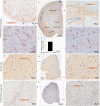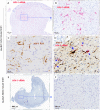Human Microglia Extensively Reconstitute in Humanized-BLT Mice With Human Interleukin-34 Transgene and Support HIV-1 Brain Infection
- PMID: 34093573
- PMCID: PMC8176960
- DOI: 10.3389/fimmu.2021.672415
Human Microglia Extensively Reconstitute in Humanized-BLT Mice With Human Interleukin-34 Transgene and Support HIV-1 Brain Infection
Abstract
Humanized bone marrow-liver-thymic (hu-BLT) mice develop a functional immune system in periphery, nevertheless, have a limited reconstitution of human myeloid cells, especially microglia, in CNS. Further, whether bone marrow derived hematopoietic stem and progenitor cells (HSPCs) can enter the brain and differentiate into microglia in adults remains controversial. To close these gaps, in this study we unambiguously demonstrated that human microglia in CNS were extensively reconstituted in adult NOG mice with human interleukin-34 transgene (hIL34 Tg) from circulating CD34+ HSPCs, nonetheless not in hu-BLT NOG mice, providing strong evidence that human CD34+ HSPCs can enter adult brain and differentiate into microglia in CNS in the presence of hIL34. Further, the human microglia in the CNS of hu-BLT-hIL34 NOG mice robustly supported HIV-1 infection reenforcing the notion that microglia are the most important target cells of HIV-1 in CNS and demonstrating its great potential as an in vivo model for studying HIV-1 pathogenesis and evaluating curative therapeutics in both periphery and CNS compartments.
Keywords: HIV-1; Hu-BLT mice; NOG mice; interleukin-34; microglia.
Copyright © 2021 Zhang, Lohani, Cheng, Wang, Guo, Kim, Gorantla and Li.
Conflict of interest statement
The authors declare that the research was conducted in the absence of any commercial or financial relationships that could be construed as a potential conflict of interest.
Figures





Similar articles
-
Human Interleukin-34 facilitates microglia-like cell differentiation and persistent HIV-1 infection in humanized mice.Mol Neurodegener. 2019 Mar 5;14(1):12. doi: 10.1186/s13024-019-0311-y. Mol Neurodegener. 2019. PMID: 30832693 Free PMC article.
-
HIV-1 infection of microglial cells in a reconstituted humanized mouse model and identification of compounds that selectively reverse HIV latency.J Neurovirol. 2018 Apr;24(2):192-203. doi: 10.1007/s13365-017-0604-2. Epub 2017 Dec 18. J Neurovirol. 2018. PMID: 29256041 Free PMC article.
-
Engineering HIV-1-resistant T-cells from short-hairpin RNA-expressing hematopoietic stem/progenitor cells in humanized BLT mice.PLoS One. 2012;7(12):e53492. doi: 10.1371/journal.pone.0053492. Epub 2012 Dec 31. PLoS One. 2012. PMID: 23300932 Free PMC article.
-
Immune reconstitution of the female reproductive tract of humanized BLT mice and their susceptibility to human immunodeficiency virus infection.J Reprod Immunol. 2011 Mar;88(2):195-203. doi: 10.1016/j.jri.2010.11.005. Epub 2011 Jan 21. J Reprod Immunol. 2011. PMID: 21256601 Free PMC article. Review.
-
BLT humanized mice as a small animal model of HIV infection.Curr Opin Virol. 2015 Aug;13:75-80. doi: 10.1016/j.coviro.2015.05.002. Epub 2015 Jun 12. Curr Opin Virol. 2015. PMID: 26083316 Free PMC article. Review.
Cited by
-
Human Immune System Reconstitution in NOD/Shi-Prkdcscid Il2rgem1/Cyagen Mice to Study HIV Infection: Challenges and Pitfalls.Life (Basel). 2025 Jul 18;15(7):1129. doi: 10.3390/life15071129. Life (Basel). 2025. PMID: 40724631 Free PMC article.
-
Derivation of resident macrophages and construction of tumor microenvironment in Flk-1-knockout chimeric mice produced via blastocyst complementation.Sci Rep. 2025 Jul 29;15(1):27665. doi: 10.1038/s41598-025-12571-w. Sci Rep. 2025. PMID: 40730607 Free PMC article.
-
High-fat diet feeding exacerbates HIV-1 rectal transmission.mSystems. 2024 Mar 19;9(3):e0132223. doi: 10.1128/msystems.01322-23. Epub 2024 Feb 2. mSystems. 2024. PMID: 38303112 Free PMC article.
-
HIV-1 infection of genetically engineered iPSC-derived central nervous system-engrafted microglia in a humanized mouse model.J Virol. 2023 Dec 21;97(12):e0159523. doi: 10.1128/jvi.01595-23. Epub 2023 Nov 30. J Virol. 2023. PMID: 38032195 Free PMC article.
-
Development of a human glioblastoma model using humanized DRAG mice for immunotherapy.Antib Ther. 2023 Oct 4;6(4):253-264. doi: 10.1093/abt/tbad021. eCollection 2023 Oct. Antib Ther. 2023. PMID: 38075240 Free PMC article.
References
Publication types
MeSH terms
Substances
Grants and funding
LinkOut - more resources
Full Text Sources
Medical
Molecular Biology Databases
Miscellaneous

